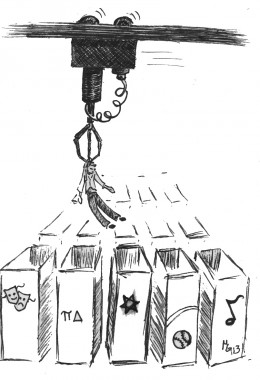
On Aug. 26, our idea of diversity was challenged and redefined.
Binghamton University President Harvey Stenger announced that the Office of Diversity, Equity and Inclusion will replace the Affirmative Action Office. As a university community, this move ought to prompt us to step back and take a hard look at diversity on campus. This means facing the truth behind the numbers – the truth that people don’t want to face: Our campus is defined and confined by diversity.
So let’s step back. Diversity begins and ends with student groups. Student groups give our school its small feel and drive student social life. Whether you’re a tenor in an a cappella group, a staunch College Republican, a pinny-clad frat brother or an adventurous young LARPer, campus life revolves around clubs. But from cultural student unions to fraternities, club members hang out predominantly with other club members. Our social lives are club-driven, and our clubs are culture-driven. This leaves a lot of us only hanging out with people of the same background.
For the student looking to bridge diversity and create friendships across ethnic and cultural lines, these echo-chambers of identity form serious barriers. For students who want to meet different types of people and get out of their own social spheres, it’s basically impossible. With no one else trying to break out, either, the segregation is so ingrained in our school that it’s become normal. We’ll offer ourselves as an example. Take us young journalists: Our staff is, admittedly, composed of mostly Jewish New Yorkers. As the student voice on campus, we attend many cultural nights and ethnic events to cover them in the paper. Despite the fact that the expressed purpose of many of these club-hosted nights is to spread awareness of, say, Polish or Haitian culture, the fact of the matter is that our reporters are the only ones in attendance who aren’t Polish or Haitian.
Then look at Downtown, where students come together to celebrate one thing we all have in common: an intense love for drinking. The parties are culturally driven, the frats are culturally driven, even State Street is divided between frat kids and non-frat kids once you pass the invisible line starting at JT’s. There are a lot of invisible lines at this school, and we’re very good at ignoring them. We pride ourselves on our cultural diversity and have the stats to back it up, with over 2,000 international students from over 90 countries. We love talking numbers. But do these statistics rhyme with our real-life experiences? What are we to make of the monochromatic social cliques that walk everywhere together and Mandela Room events we know nothing about? Why don’t we talk about how our broad array of student groups also turns our social circles into internal clusters (and don’t claim your fraternity’s mixer counts as crossing out of your comfort zone)? We remain painfully socially divided rather than intertwined as part of a global institution. If that’s what being a diverse school means, then what’s the point?
This month, the Office of Diversity, Equity and Inclusion is sending a survey to all students about diversity on campus. Think critically about diversity at Binghamton and how you will respond. Think about the last time you friended a foreign student on Facebook or the last time you went to a party hosted by a group affiliated with a cultural background different than your own. And if you’re drawing a blank, you’re probably a Binghamton student.


